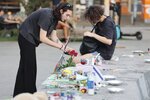


.jpg)
TEL AVIV, Israel — It’s a nightmare scenario that no parent would ever want to experience.
Two weeks after five members of her family were taken captive by Hamas militants on Oct. 7, two somber-faced members of the Israeli Defense Forces approached the home Hadas Kalderon has been staying at with a friend in Tel Aviv after hers was destroyed in the attacks.
She told them to go away before slowly collapsing to the floor crying in grief. She couldn’t bear to hear the news.
Shortly after 6:30 a.m. on Oct. 7, under the cover of hundreds of rockets being launched from the Gaza Strip into Israel, the militants broke through the security fence separating several kibbutzim along the southeastern border with the Palestinian territory.
Over the course of the next two hours, 29 of Kibbutz Nir Oz’s 400 residents would be murdered, and 80 would be taken captive and across the border, to be secreted somewhere in Gaza. Among them were her two youngest children, son Erez, 12, and daughter Sahar, 16; their father, Ofer, 53; her mother Carmela, 80; and niece Noya, 12.
“I told them, ‘go away, I don’t want to hear from you,’” Kalderon told the Rhode Island Catholic. “Who are they going to tell me is dead? I don’t know.”
“Now, [in my mind] I have to choose. I am asking myself: ‘Who are you going to tell me?’ I was praying I don’t want anyone to die, but just not my children,” she said, crying.
The day before, Kalderon had organized a party to mark her mother’s 80th birthday, complete with a festive chocolate cake adorned with two, huge glittery candles forming the digits of her milestone age atop it.
This day, she would learn from the soldiers at her door that her mother and Noya, who was autistic, were found murdered in Gaza.
The last communication with her children came in the form of a frantic text message from another home in the kibbutz as the attack unfolded.
“They told me that they also have terrorists inside their house, and so they jumped from the window and were hiding in the bush. This was the last message I got from them,” Kalderon said.
At the time she was experiencing a nightmare of her own. The Hamas militants had now raided her home as well.
She described them as bloodthirsty, going house to house murdering and butchering residents, and even any cats or dogs they came across.
“I was in a safe room, all alone for eight hours, in the dark, with no electricity, no phone, no information, no water, no food, no nothing. For eight hours I was holding the door because they came into my house and broke everything and tried to go inside, and also through the window,” Kalderon said.
“I was sure I wouldn’t survive. I already prepared for my death. I said, ‘I’m in a jungle, I have to survive.’ I heard a lot of shouting and shooting, a lot of noise, a lot of Allahu Akbar (God is Great) and other Arabic words. It was a terrifying nightmare.”
She held the doorknob to the safe room as tightly as she could, because the reinforced safe rooms are designed to protect occupants from bomb attacks, not terrorist intrusions, while she prayed.
“It was just me and God. I prayed. I could hear just the terrorists and the birds, nothing else; I remember that,” she said.
The only proof she has that Erez was alive, at least as of the date it was filmed, is a video clip released by Hamas of him being taken into captivity.
“We saw that my son was picked up by two terrorists, carried away, with a lot of shouting. His face looked terrified and helpless and so confused,” she said of the video.
They had been taken from their home still dressed in pajamas, as it was very early in the morning.
Kalderon spends most days in Tel Aviv now joining other hostage family members in telling their stories to the media in order to keep the focus on those being held captive amid a destructive air and ground campaign being waged that has also killed thousands of innocent Palestinians caught in the crossfire.
She steadies her nerves with a cigarette as she worries about the safety of her remaining family in captivity, and how much violence they have been exposed to.
The U.S. has designated Hamas as a terror organization because it categorically rejects Israel’s right to exist. The group has also dedicated itself to the creation of a Palestinian state in the Holy Land through the use of violence.
The overall sentiment among Israelis is strongly in favor of removing Hamas from the power it has held in Gaza since it took control of the Strip from Fatah, the rival Palestinian political party, following a civil war in 2007, and has run it since as an autocratic state.
But the families of those taken hostage are calling for a more pragmatic approach in order to protect the lives of as many as possible.
“I’m a mom, I’m not a politician, not an army girl, I just want to believe they behave wisely with good judgement, and they know what they are doing,” Kalderon says of the Israeli government, which she feels should exchange whatever number of Palestinian prisoners are asked for by Hamas to secure the release of the hostages.
“What I want is to save my children. It’s not a game for children. You can’t make war at the expense of children. They are victims. We don’t know when it’s going to end.”
Her son had already been experiencing panic attacks, the result of living under constant rocket attacks on Israel by Hamas, and she said she would sit with him for one hour each night as he fell asleep.
“My girl and my boy are very sensitive children, very fragile, and I can’t even imagine what they go through,” she said.
It is the unspoken that is Kalderon’s deepest fear.
“My beautiful girl, she’s 16 and a teenager. Do you have children, do you have a daughter? Then try to imagine that,” she said.
While Kalderon moved away for 10 years from Kibbutz Nir Oz, where she was born, she moved back there to start a family, despite the dangers living in the Gaza Envelope presented.
Set peacefully amid agricultural land, in an area visited by the Rhode Island Catholic last December, Nir Oz offers open space for children to ride horses and bikes and to play soccer, activities that Erez greatly enjoyed in better times.
Sahar loved to play guitar, and to dance. She also liked to play ping-pong and to draw.
“Who’s going to calm my boy when he’s hysterical,” she asks. “It drives me nuts. It breaks my heart; I prefer not to think.
About 1,200 people of Israeli and other nationalities were killed, and about 240 taken hostage in the Oct. 7 attacks, including about 30 children. About 60 Israeli service members have been killed so far during Operation Swords of Iron.
Israel began its response to the Oct. 7 attacks with an air campaign to eliminate Hamas resistance to protect the lives of the ground troops who would storm the Strip three weeks to the day later. Thousands of innocent Palestinians have been killed in the crossfire along with the intended targets, and Christian churches providing aid have also been damaged in the strikes.
The Gaza Ministry of Health, which is run by Hamas, and is the only internal source of casualty information available to the media, said Nov. 19 that at least 13,000 Palestinians have been killed, including about 3,000 children, and 30,000 wounded by Israeli strikes since Oct. 7.
Additionally, about 48 journalists and media workers have also been killed in the region since the conflict began, according to the Committee to Protect Journalists.